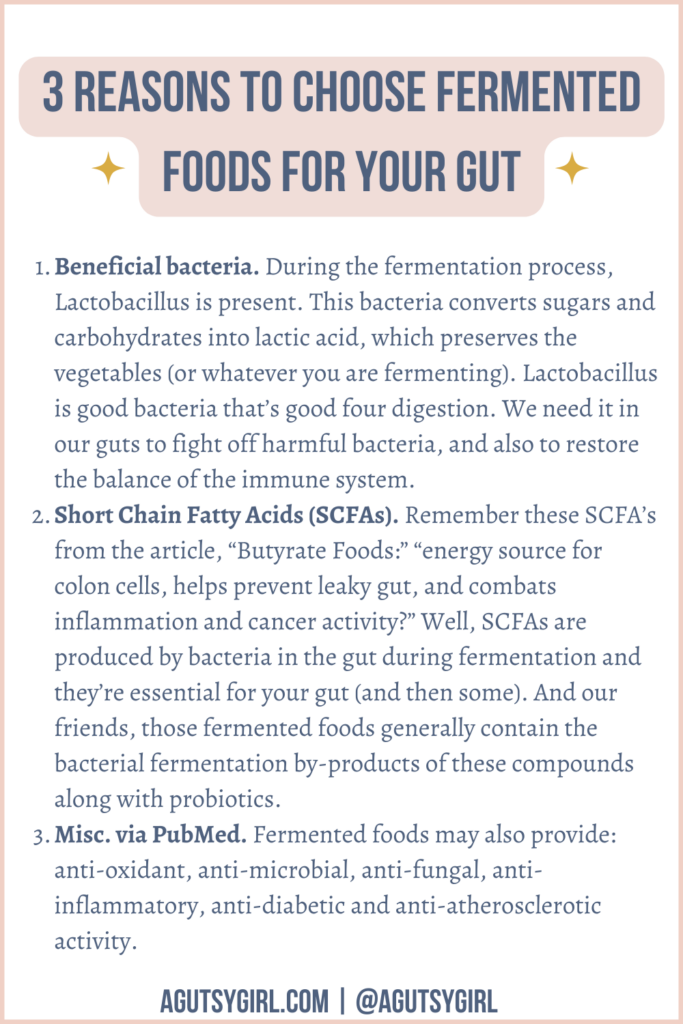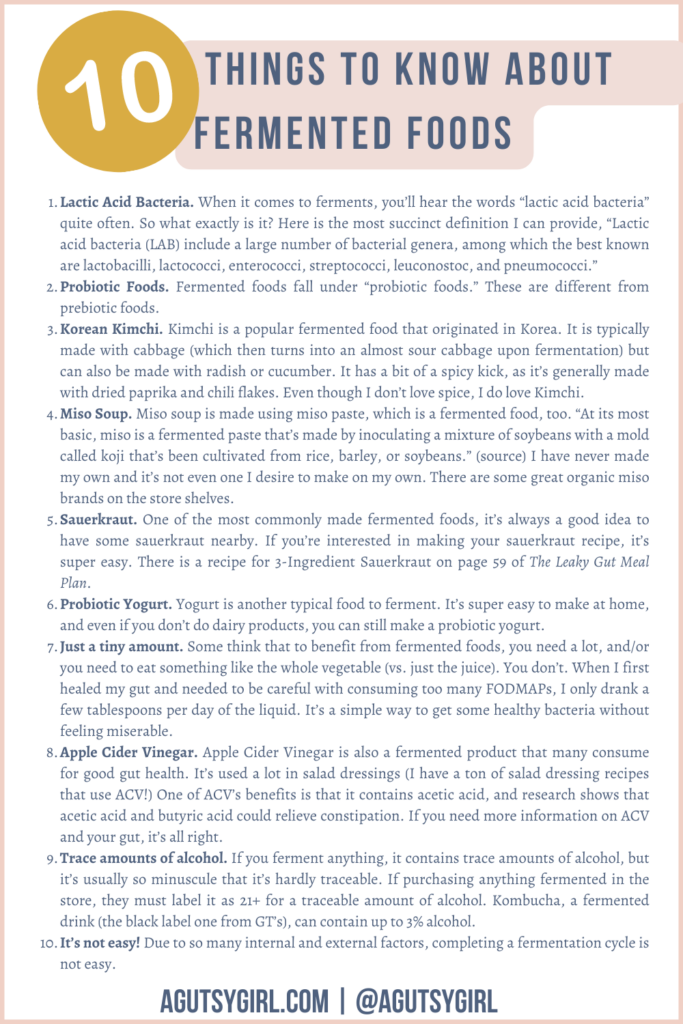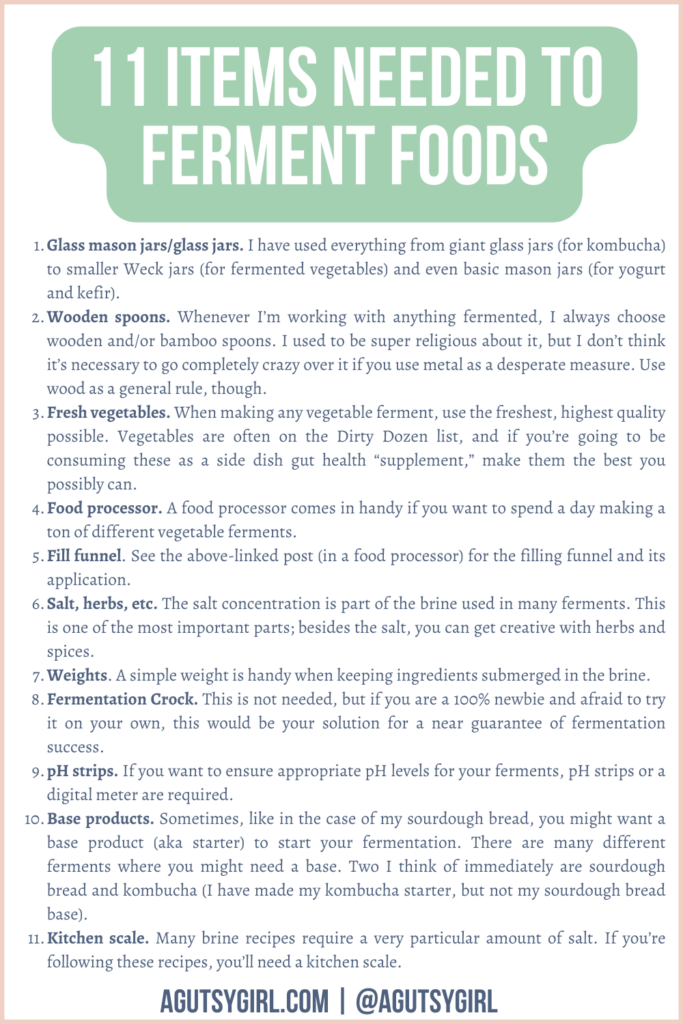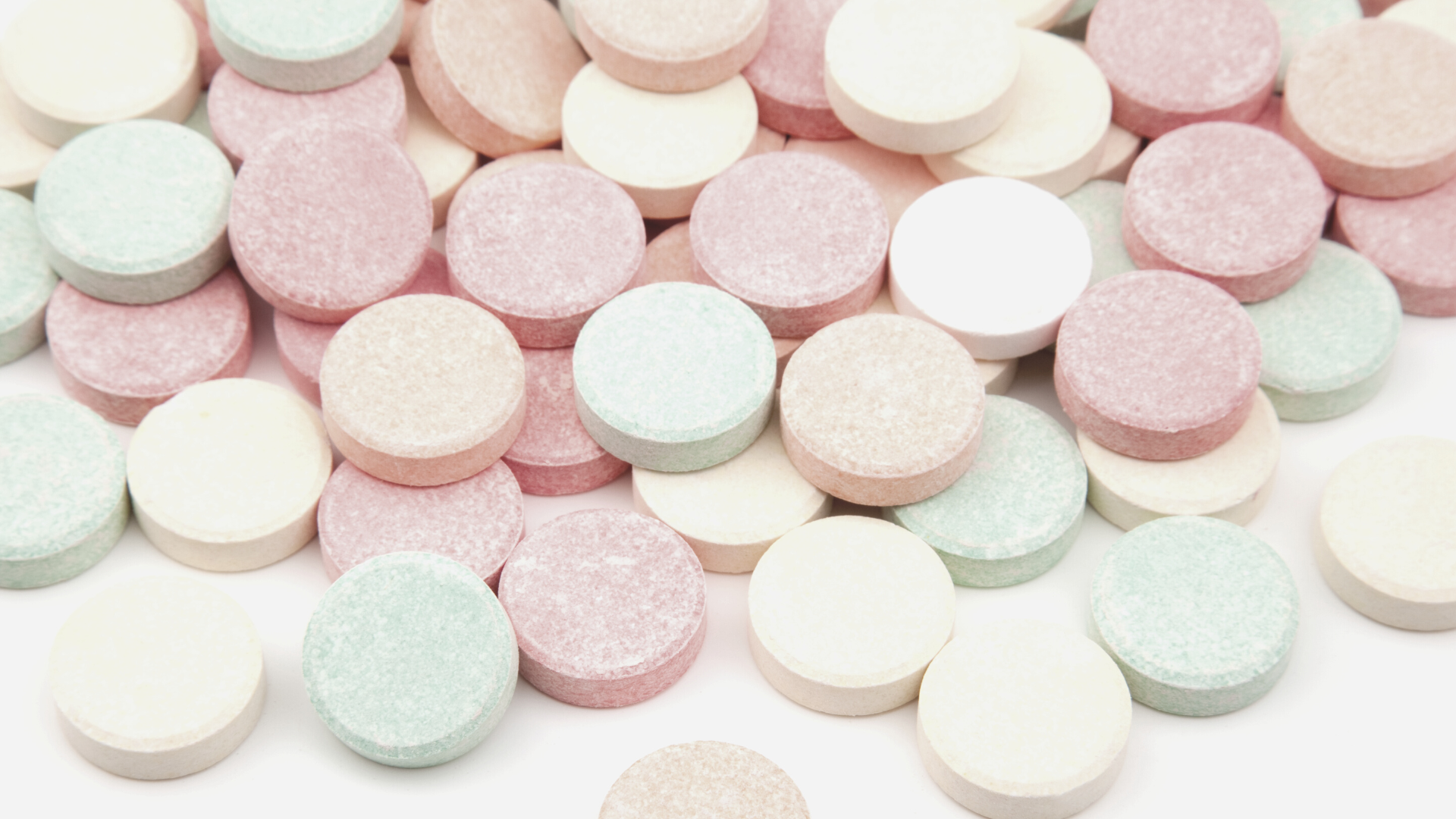The health benefits for gut healing are endless when it comes to the fermentation process. So I thought it might be helpful for me to put together a massive post on fermented essentials.
Remember, my goal throughout September is to join in on Vanessa Kimbell’s Sourdough September with A Gutsy Girl’s Fermented September. More on all things sourdough HERE.
Fermented Foods: An Important Role in Gut Health
Consuming fermented foods on a regular basis is conducive for optimal gut health.
The most common fermented foods include:
- yogurt
- vegetables
- kombucha
- beer
- wine
- kefir
- sourdough bread
- pickles
- sour cream
I have made the above into tasty ferments except for beer, wine, and sour cream.
The reason is because fermented foods are an easy way to better digestive health. And I’m all about the optimal microbiome!
Here are the main reasons why we choose fermented foods in the gut health community:
- Beneficial bacteria. During the fermentation process, Lactobacillus is present. This bacteria converts sugars and carbohydrates into lactic acid, which preserves the vegetables (or whatever you are fermenting). Lactobacillus is good bacteria that’s good for digestion. We need it in our guts to fight off harmful bacteria, and also to restore the balance of the immune system.
- Short Chain Fatty Acids (SCFAs). Remember these SCFA’s from the article, “Butyrate Foods:” “energy source for colon cells, helps prevent leaky gut, and combats inflammation and cancer activity?” Well, SCFAs are produced by bacteria in the gut during fermentation and they’re essential for your gut (and then some). And our friends, those fermented foods generally contain the bacterial fermentation by-products of these compounds along with probiotics.
- Misc. via PubMed. Fermented foods may also provide: anti-oxidant, anti-microbial, anti-fungal, anti-inflammatory, anti-diabetic and anti-atherosclerotic activity.
Sources: HERE, HERE, and HERE.

Alright, so now that it’s clear as my last colonoscopy (true, but also ha ha ha ha) as to why we love these lactic acid fermentations (i.e. fermented foods), let’s talk about the essentials you’ll need for getting started on your own fermentation journey.
Want to learn even more about the gut and ways to heal it? Learn all the secrets via my signature book, A Gutsy Girl’s Bible: a 21-day approach to healing the gut. Grab your copy on Amazon HERE.
Or, have this book at your fingertips instantly by downloading the PDF now.
Fermented Essentials {What to Know + Items Needed}
Click HERE to save this post on fermentation essentials for later.

Now, it should be noted that every single time I have done fermentation projects, I’ve always used glass jars. Therefore, be sure to take special note of that one.
Regardless, here are some fermented essentials for what to know + fermented essentials needed.
10 Things to Know About Fermented Foods
- Lactic Acid Bacteria. When it comes to ferments, you’ll hear the words “lactic acid bacteria” quite a bit. So what exactly is it? Here is the most succinct definition I can provide, “Lactic acid bacteria (LAB) include a large number of bacterial genera among which the best known are lactobacilli, lactococci, enterococci, streptococci, leuconostoc, and pediococci.” There is full, comprehensive information about it HERE.
- Probiotic Foods. Fermented foods fall under “probiotic foods.” These are different than prebiotic foods. I have laid out the differences (along with examples of each) for probiotic vs. prebiotic foods HERE.
- Korean Kimchi. Kimchi is a popular fermented food which originated in Korea. It is typically made with cabbage (which then turns to an almost sour cabbage upon fermentation), but can also be made with radish or cucumber. It has a bit of a spicy kick to it, as it’s generally made with dried paprika and chili flakes. Even though I don’t love spice, I do love Kimchi.
- Miso Soup. If you want a delicious Vegan, Gluten Free Miso Soup, you must try THIS one. Miso soup is made using miso paste, which is a fermented food, too. “At its most basic, miso is a fermented paste that’s made by inoculating a mixture of soybeans with a mold called koji that’s been cultivated from rice, barley, or soybeans.” (source) I have never made my own and it’s not even one I desire to make on my own. There are some incredible organic miso brands on the store shelves.
- Sauerkraut. One of the most commonly made fermented foods, it’s always a good idea to have some sauerkraut nearby. If you’re interested in making your own sauerkraut recipe, it’s super easy. There is a recipe for 3-Ingredient Sauerkraut on page 59 of The Leaky Gut Meal Plan.
- Probiotic Yogurt. Yogurt is another common food to ferment. It’s super easy to make at home, and even if you don’t do dairy products you can still make a probiotic yogurt. Don’t believe me? Check out this probiotic-rich Coconut Yogurt recipe HERE.
- Just a small amount. Some think that in order to benefit from fermented foods you need a lot and/or you need to eat something like the whole vegetable (vs. just the juice). You don’t. In fact, when I was first healing my gut and needed to be careful with consuming too many FODMAPs, I only consumed a few tablespoons per day of the liquid. It’s a simple way to get some healthy bacteria without feeling miserable.
- Apple Cider Vinegar. Apple Cider Vinegar is also a fermented product that many consume for good gut health. It’s used a lot in salad dressings (I have a ton of salad dressing recipes that use ACV!) One of ACV’s benefits is that it contains acetic acid, and research shows that both acetic acid and butyric acid could relieve constipation. In case you need more information on ACV and your gut, it’s all right HERE.
- Trace amounts of alcohol. If you ferment anything, it contains trace amounts of alcohol, but it’s usually so minuscule that it’s hardly traceable. If purchasing anything fermented in the store, they have to label it as 21+ for traceable amount of alcohol. Kombucha, which is a fermented drink (the black label one from GT’s) can contain up to 3% alcohol.
- It’s not easy! Due to so many factors, both internal and external factors, successfully completing a fermentation cycle is not easy.

11 Items Needed to Ferment Foods
- Glass mason jars / glass jars. I have used everything from huge glass jars (for kombucha) to smaller Weck jars (for fermented vegetables) and even basic mason jars (for yogurt and kefir).
- Wooden spoons. Whenever I’m working with anything fermented, I always choose wooden and/or bamboo spoons. I used to be super religious to it, but I don’t think it’s necessary to go completely crazy over if you use metal as a desperate measure. Use wood as a general rule, though.
- Fresh vegetables. When you’re making any vegetable ferment, use the freshest, highest quality possible. Vegetables are often on the Dirty Dozen list, and if you’re going to be consuming these as a side dish gut health “supplement,” make them the best you possibly can.
- Food processor. A food processor comes in super handy if you want to spend a day making a ton of different vegetable ferments. If you want to see this in action + grab different vegetable concoctions, HERE is where you’ll find it all.
- Fill funnel. See the above linked post (in food processor) for the fill funnel and its application.
- Salt, herbs, etc. The salt concentration is part of the brine used in many ferments. This is one of the most important parts and, besides the salt, you can get very creative with herbs and spices.
- Weights. When you need to keep ingredients submerged in the brine, a simple weight is super handy.
- Fermentation Crock. This is not needed, but if you are a 100% newbie and afraid to try it on your own, this would be your solution for a near guarantee fermentation success.
- pH strips. If you want to ensure appropriate pH levels for your ferments having pH strips or a digital meter is required.
- Base products. Sometimes, like in the case of my sourdough bread, you might want a base product (aka starter) to get your fermentation started. There are many different ferments where you might need a base. Two I think of immediately are the sourdough bread and kombucha (I have made my own kombucha starter, but not my own sourdough bread base).
- Kitchen scale. Many brine recipes require a very particular amount of salt. If you’re following these recipes, you’ll need a kitchen scale.

Remember, just a single dose of fermentation can go a long way.
I don’t think I’ll ever stop sharing about fermented foods because of their high value for the almighty gut.
If you liked this post on fermented essentials, you might also enjoy:
- 10 Probiotic Recipes to Start the New Year
- SIBO Diet Recipes – A Gutsy Girl Way
- 13 Probiotic Benefits Beyond Gut Health
Xox,
SKH
🤰 bloating be gone! weight loss through optimal gut health for women
💃ʜᴇᴀʟ ʏᴏᴜʀ ɢᴜᴛ. ʜᴇᴀʟ ʏᴏᴜʀ ʟɪfe.
🫶🏻 founder gutbyome.com





